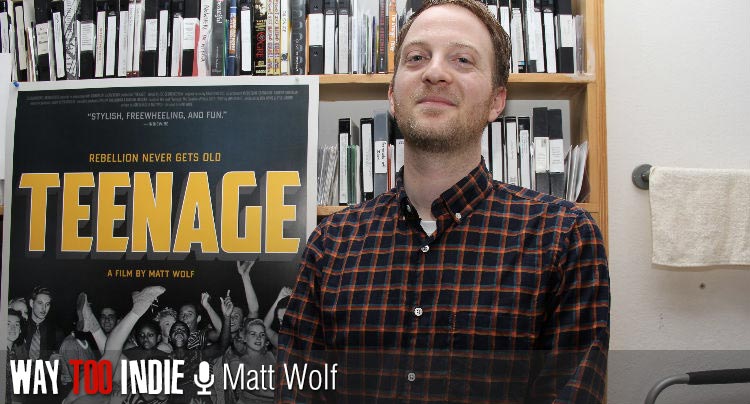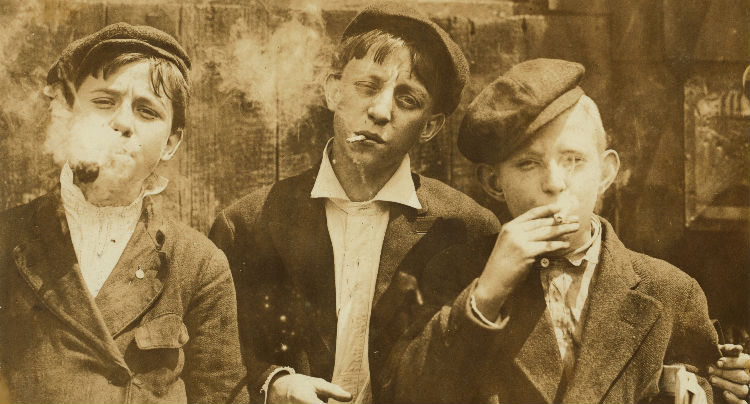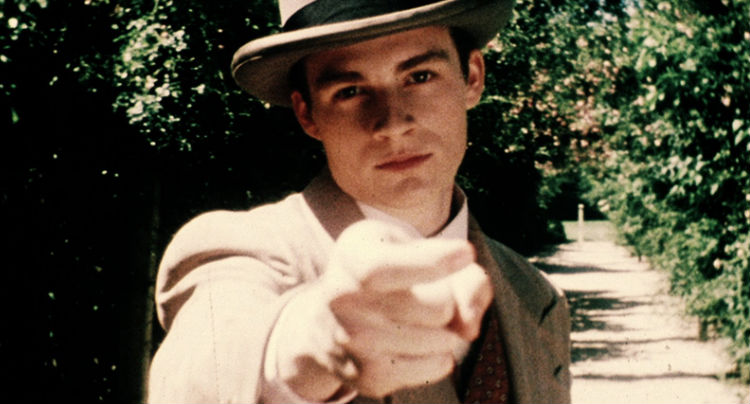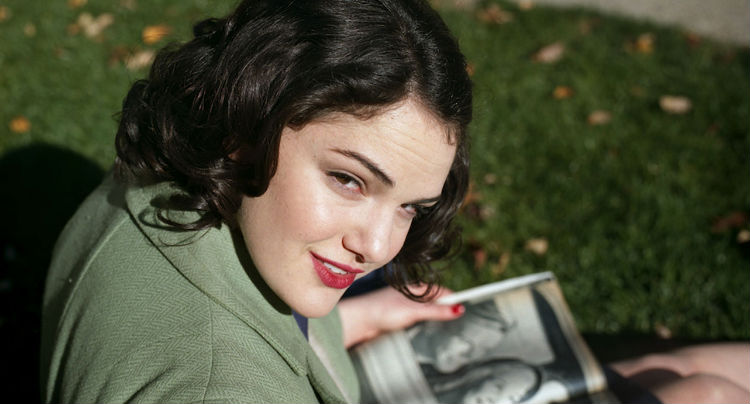Matt Wolf Bridges Past and Present Youth Culture in ‘Teenage’

With Teenage, filmmaker Matt Wolf chronicles the rise of the phenomenon known as the teenager from its inception around World War I and through World War II. Based on the book by Jon Savage, the film blends archival footage, reenactments, narration of old diaries, and a contemporary soundtrack to chronicle the rise of teenagers from a subjective, expressionistic viewpoint. It illuminates the seldom explored history of Hitler Youth, Flappers, Swing Kids, and more youth subcultures of the time who were sacrificed by their parents to war, giving them a cinematic voice.
Matt sat with us in San Francisco to talk about creating a dreamlike historical movie, blending archival footage seamlessly with reenactments, why music is the most influential art form in pop culture, why Anne Frank probably would have been a “Belieber”, and much more.

Many historical documentaries these days tend to be full of talking heads, names, dates, and feel a bit cold. Teenage doesn’t seem aimed at the brain in the same way, targeting the emotions instead.
Matt: Most historical films are expert-led and tend to explain things in a very literal manner. This film is more expressionistic and impressionistic. I wanted it to have a dreamlike quality. It’s a subjective history, so it’s told from the point of view of youth. I also think of the film as having the quality of a record. The film has music almost wall-to-wall. You can listen to it in the way you would listen to a record, and the voiceover narration almost functions like lyrics.
There’s an immediacy to the film. None of it is based in hindsight from the present day.
Matt: To me, that’s because of the music. I always had this premise that if you combine contemporary music with vintage archival footage that it’s transformative. I did experiments where I played the Original Dixieland Jazz Band alongside footage of flappers dancing, and it felt very stodgy. “That’s what my great grandparents would listen to.” When you play contemporary music with that footage, it’s totally transformative. You say, “That’s me. I would have been dressed like that. I would have been dancing with that person.” That gives immediacy to the material. My goal is to look to not just the recent past, but the distant past, to help us reconsider what the role of youth is today and intervene in our attitudes of youth today by examining history.
How important do you think it is for today’s youth to look back to the roots of this teenage phenomenon and discover how cyclical and relevant it is today?
Matt: I’ve shown the film to a lot of teenagers and worked with teenagers in some of the film’s recreations. The girl who played Melita Maschmann isn’t a real actress–she’s a kid we found in Tompkins Square Park in the East Village. She’s going through her own kind of rebellious episode in her life, and she got involved in Occupy Wall Street during high school. While I was explaining and giving her context as to why Melita Maschmann, a Hitler Youth, got involved in the political movement, the thing she could relate to it was her involvement in Occupy Wall Street. The context is radically different, but that’s what she was channeling. When she went to the premiere, she said, “This stuff really resonates with how I feel.” You have a contemporary girl channeling the experiences of a Nazi Youth, but there’s an emotional kernel there that transcends political circumstances and historical specificity. I think that was the goal of the film.
World War I started this whole teenage thing, correct?
Matt: Yeah. The notion of a generation gap really came from WWI. There hadn’t been that kind of mass devastation before, so when young people were thrown into combat like that and massacred or shell-shocked, there was this sense of disbelief that adults could sacrifice them as cannon fodder in that way. It’s what created a sort of antagonism between the old and the young. That’s what created the flapper culture of the 1920s and the partying and rebellion. The film is really bracketed by war. War has a transformative effect on the role youth plays in society. More often than not, they’re used as cannon fodder.
You focus on the youth of three countries in the film, America, England and Germany. What were the differences in circumstance between them, and why use those three specifically?
Matt: It was important for this global, panoramic topic to telescope the focus. Of course, I’m adapting a book, and that was the focus of Jon’s book. I feel that the competing definitions of youth were playing out most significantly in those three countries at that time. In America, it was the rise of democratic consumerism. In Germany, there was the rise of Fascism, regimentation, militarization. England was really important because it was the gateway of American culture into Europe. You hear in the narration about swing finding its way into Europe through England. They fetishized that music because it came from America. It’s these competing models of youth that collide into this convention of the teenager by the end of World War II.
I love the line in the movie where a parent in England asks their kid why they like jazz music so much, and the kid replies with, “Because it’s from America.”
Matt: It’s interesting, because I think that still plays out in a more globalized youth culture now. After the war, youth culture becomes a much more global phenomenon, and it would be appropriate to telescope into these three Western countries. These are the seeds of something that would explode. Still to this day, American youth and pop culture has a resonance all over the world, for better or for worse.
There are reenactments in the film, but it doesn’t feel like there are. It’s very seamless.
Matt: We went about doing the reenactments through non-digital techniques. My cinematographer Nick Bentgen did a ton of research into the original 16mm hand crank Bolex cameras that were used and finding uncoded C mount lenses. We shot in that way, but then we did chemical processes that are almost like VHS dubs. They’d soften and degrade the image through each round of chemical treatment. Then, we hand-degraded stuff by sort of stepping on it, moving it across the floor, putting coffee filter stains and bleach stains of the footage…The only thing that was done digitally was the color. For the 1920s material, we looked for references of what color film footage looked like from that period and did experiments. It was all about trying to figure out how to do it non-digitally and to do it in the way young people would have documented themselves at that time.

So you’re also mimicking the camera style of that time.
Matt: Yeah. The way I wanted my footage to look was inspired by archival footage I found when we were creatively planning for our recreations. I didn’t want it to feel like America’s Most Wanted, as the most extreme example. Often times recreations mark themselves and feel very contemporary. For me, I’m interested in creating visual material that feels native to the time that it’s depicting. If I was shooting a recreation about today, I would shoot in HD, but I’m shooting material representing the ’20s, ’30s, and ’40s, so I wanted it to look like that format of that time. It can be kind of controversial, this blending of constructed and real material. But it’s about not jarring the viewer out of the film experience and create an organic, holistic thing.
Also in line with that is the film’s narration. Some of that is scripted as well, though some of it is read from real diaries. Again, it’s hard to tell which is which.
Matt: We wanted to lend a certain authenticity to the dialogue, so we sourced hundreds of quotes from actual teenage diaries and testimonies. Of course, the overall collaging of these quotes is a script. There are some constructive lines of dialogue that propel our narrative forward. This blending of fact and fiction has a dreamlike quality that affects the overall tone of the film.
What dictated the direction and structure of the story you wanted to tell? Was it the book, the footage, the archival material…
Matt: It was the footage. Jon and I had this rule where, any story we told had to have a strong basis in archival footage. There were all sorts of structural things we were trying to achieve. There’s an interplay between the different countries and the various voices of the narrators, but also, we wanted to show the evolving idea of what youth was. We also wanted to play out from beginning to end what happened in Nazi Germany, how youth were empowered and sacrificed. We wanted to show in America how youth began as this kind of social problem and ended as this economic opportunity for marketers. Of course, the invention of the teenager isn’t a clear science of, A+B=Teenager. It was an idea that really percolated in the culture. It was hard to construct what feels like a linear narrative.
Why is music the most influential of all artistic mediums in pop culture?
Matt: I think, for one, music is a very emotional thing. Film is very emotional, but I think people have really personal, emotional relationships with music, whether it’s through the lyrics or aesthetics. Music breeds subculture as well. It invites unique forms of slang, different fashions, signature forms of dance…and that creates a broader culture around music. In our film, we really look at the origins of that with jitterbug and swing music. It has its beginnings in African American culture, young people picked it up and created this slang and subculture around it, and then mass media picked up on it. That process of going from underground to youth culture to mass media and spreading to global culture is really fascinating to me. Swing meant something very different in America than it did in Nazi Germany. It was degenerate art. In Nazi Germany, young people who listened to that music and smuggled in those records were subversively rebelling against the regime and were risking their lives. Music is entertaining, but it can also be political.
The music in the film is great.
Matt: Bradford Cox of the bands Deerhunter and Atlas Sound did the soundtrack. I was drawn to him because his music naturally blurs the past and the present, and I feel like he has his own preoccupation with the topic of teenage rebellion as well.
What’s the best Deerhunter album for newcomers to start with?
Matt: I think the first album, Cryptograms, is the best to start with. Their most recent album, Monomania, is a great one. I think it’s really interesting to listen to Deerhunter’s music alongside Bradfor’s solo project Atlas Sound to get a full sense of his aesthetic. He’s a really prolific artist with a huge range.

I’d love to see you cover the Elvis and Beatles phenomena.
Matt: I think it becomes hard after the war. Youth culture explodes in such a way that the amount of information increases exponentially. Tenfold. One hundred-fold. It’s almost like you could only go from 1946 to 1951 because there’s so much information. My attitude is that I’m interested in hidden histories. Uncovering the Wandervogel and the Victory Girls is more interesting to me than showing imagery of Elvis and Beatlemania. What fascinates me more is the kid who slicks his hair back to look like Valentino.
It’s incredible that teens rioted at his funeral. No one would riot at Justin Timberlake’s funeral.
Matt: They’d riot at Justin Bieber’s funeral.
That’s true!
Matt: I think it is enduring. Justin Bieber collides with this history when he goes to the Anne Frank museum in the Netherlands and signs “You would have been a Belieber,” which was so offensive to people, but I also think it’s true; I think Anne Frank was an incredible fan of pop culture and movies. I do think she would have been a Belieber. I don’t find that offensive. He was obviously ignorant when he wrote that, but I don’t think it’s untrue.
In some ways, I think that’s what my film is getting at. These patters have presented themselves long before Justin Bieber or Lindsay Lohan were around. Our celebrity fascination with youth has deep roots, and it’s a pattern that repeats itself relentlessly.
